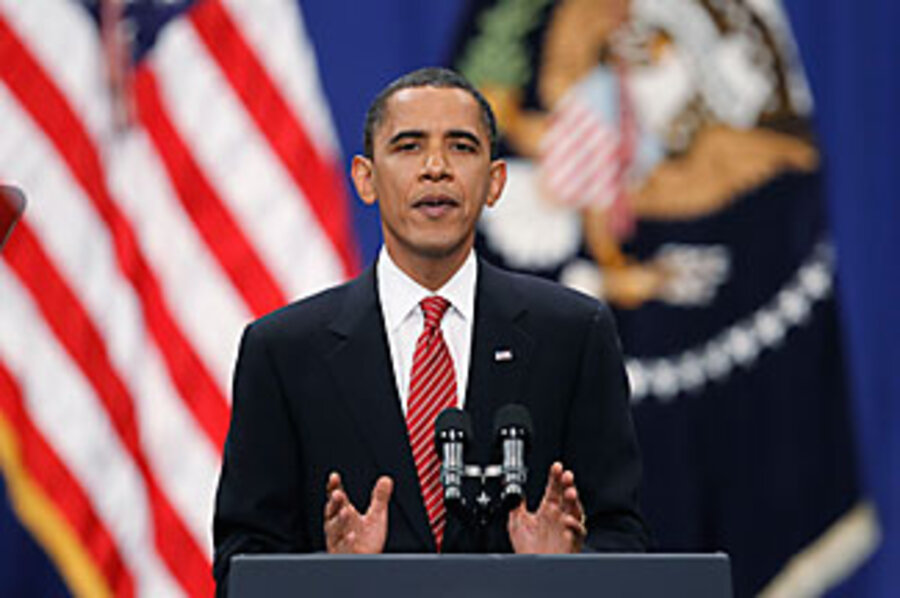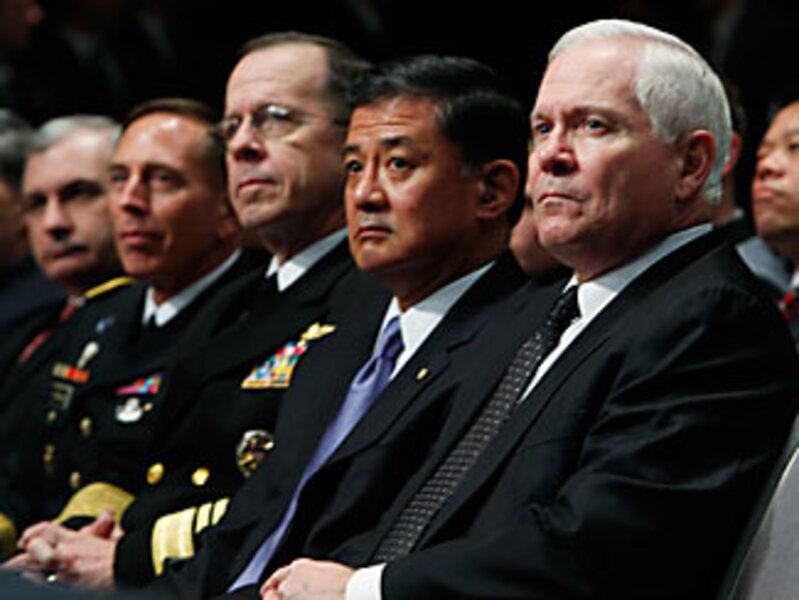Obama's Afghanistan speech: five key points
Loading...
| Washington
President Obama's Afghanistan speech announced a new, historic chapter for the mission there, announcing the deployment of 30,000 additional troops in the "epicenter of the violent extremism practiced by Al Qaeda" but also promising to begin withdrawing those forces within 18 months.
The surge of forces will bring the total American commitment to nearly 100,000. It will be composed of several combat brigades, new trainers and support troops and will be deployed at "the fastest pace possible" to be on the ground and fighting by summer, an onerous task for a military deploying forces to a landlocked country with a crude infrastructure.
The much-anticipated formal announcement of a policy in Afghanistan punctuates three months of soul-searching within the administration and, regardless of the outcome, represents an historical turning point for Afghanistan and the Obama administration.
Five key takeaways:
1. An end in sight. The most important aspect of the new Afghanistan strategy is that Obama is pledging to begin to end the American commitment there by July 2011. While he said his exit plan is "conditions based," he is also pledging to begin pulling those forces out.
"After 18 months, our troops will begin to come home," according to Obama's prepared remarks before an audience of cadets at the United States Military Academy at West Point, N.Y. "These are the resources that we need to seize the initiative, while building the Afghan capacity that can allow for a responsible transition of our forces out of Afghanistan."
That provision of the plan has already sparked pointed criticism among some conservatives who fear that it telegraphs to insurgents that they can wait out American troops.
But administration officials don't see it that way. Instead, the July 2011 date creates a goalpost the military must try to meet in terms of arresting the deteriorating security situation and training Afghan forces.
2. More Afghan forces. Predictably, a large component of the American strategy is training the Afghan forces. Democrats, in particular, have pushed the administration to make training the indigenous force a centerpiece to the strategy so American forces can ultimately leave. Gen. Stanley McChrystal, the top commander in Afghanistan, had asked to double the size of the army and police to a force of about 400,000 (the Afghan Army has about 92,000 troops currently and the police has 84,000). But the administration is not wanting to bite off more than it can chew. Instead, Obama wants to undertake the massive training effort in smaller increments, one year at a time, and re-evaluate as needed.
"So 400,000 doesn't have much weight with us," said one senior administration official Tuesday.
3. An accelerated pace. Under pressure to show success to a wary and war-weary American public, Obama has directed that the surge of forces will occur quickly, contrary to what Defense Secretary Robert Gates and Adm. Mike Mullen, chairman of the Joint Chiefs of Staff, said at the Pentagon just last week.
Under the Obama plan announced Tuesday, the US military will deploy 30,000 troops to Afghanistan over the course of eight months. That's ambitious. The surge of 30,000 forces to Iraq in 2007 took five months, but that relied heavily on Iraq's sophisticated road network, a willing partner in Kuwait, and the Iraqi port near Basra. Landlocked Afghanistan with its crude road network will offer no such welcome mat to American forces.
"The situation in Afghanistan is very different than the situation we faced in Iraq in the sense that we do not have the same kind of transportation access to Afghanistan that we did in Iraq, where we were able, over a five-month period or so, to bring in five brigade combat teams."
4. Hamid who? Obama's speech made little mention of Afghan President Hamid Karzai, seen as corrupt and ineffectual and re-elected in a fraudulent election this fall. Many believe he is incapable to be a reliable "partner" to which the US and the international community can hitch its wagon.
But American officials recognize they have little choice but to reinvent their relationship with Mr. Karzai. They will cajole and negotiate, push and force the Karzai government to operate more effectively so that it can take over governance and security within the next few years.
"Just as we have done in Iraq, we will execute this transition responsibly, taking into account conditions on the ground," Obama said. The US will continue to advise the Afghan security forces to ensure they will "succeed over the long haul." But, he said. "It will be clear to the Afghan government, and, more importantly, to the Afghan people, that they will ultimately be responsible for their own country."
5. Listening only in part to his generals. McChrystal asked for about 40,000 troops for Afghanistan, seen as a middle ground between a higher, albeit unlikely request of 80,000, and a smaller request of about 12,000 to suit a narrower mission. In agreeing to deploy 30,000 troops, Obama has taken a middle ground in terms of the numbers, and has embraced a plan largely authored by Secretary Gates.
For days, however, administration officials have tried to explain that the strategy is less about the number of forces than it is the counterinsurgency strategy itself. But a properly resourced counterinsurgency relies on numbers of troops to secure the population, choke the insurgency, and train the indigenous forces. And in fact, the 30,000 troops Obama announced Tuesday is on top of an additional 21,000 forces that have deployed to Afghanistan since Obama took office in January. [Editor's note: The original version misstated the number of forces deployed since January.]
Although Afghanistan has long been an under-resourced conflict, in their totality, the number of new forces deployed to Afghanistan represents a number far greater than the surge of about 30,000 deployed to Iraq in 2007 under President Bush.
-----
Follow us on Twitter.






